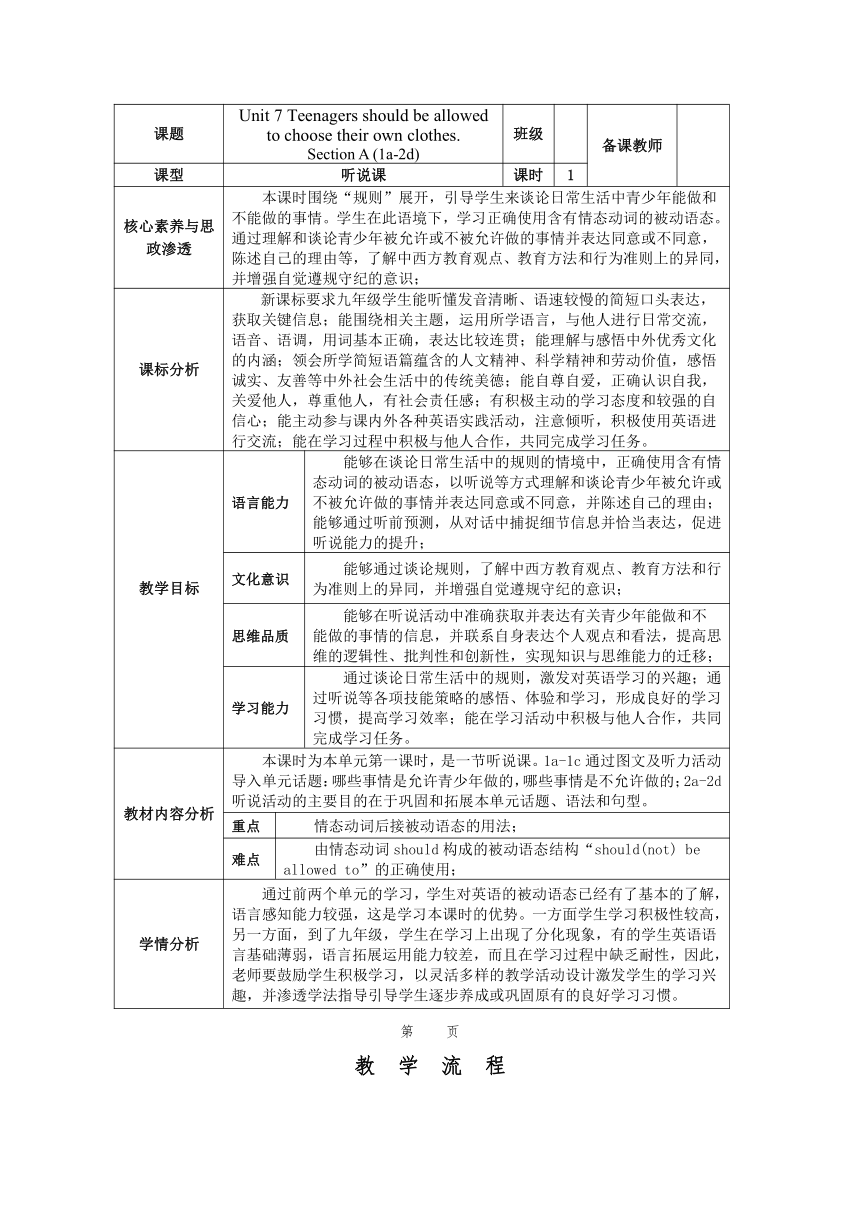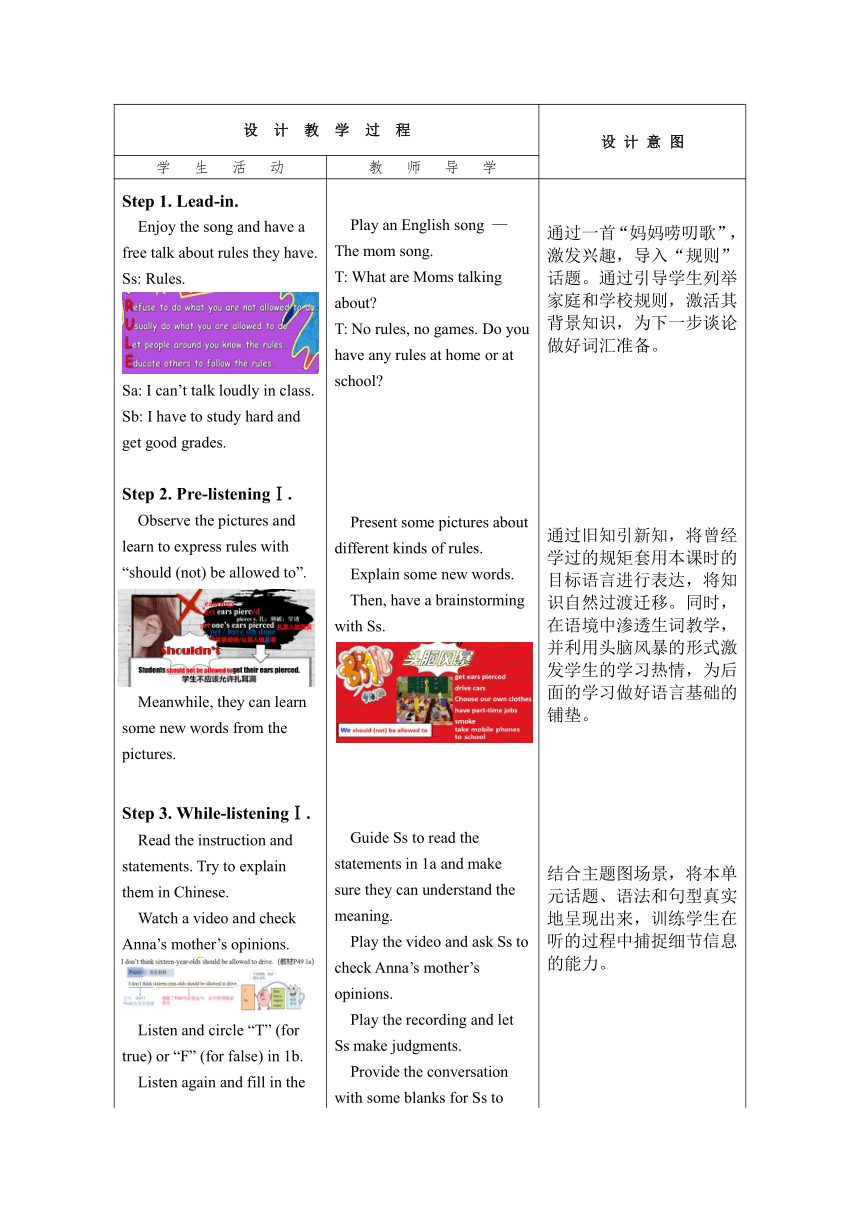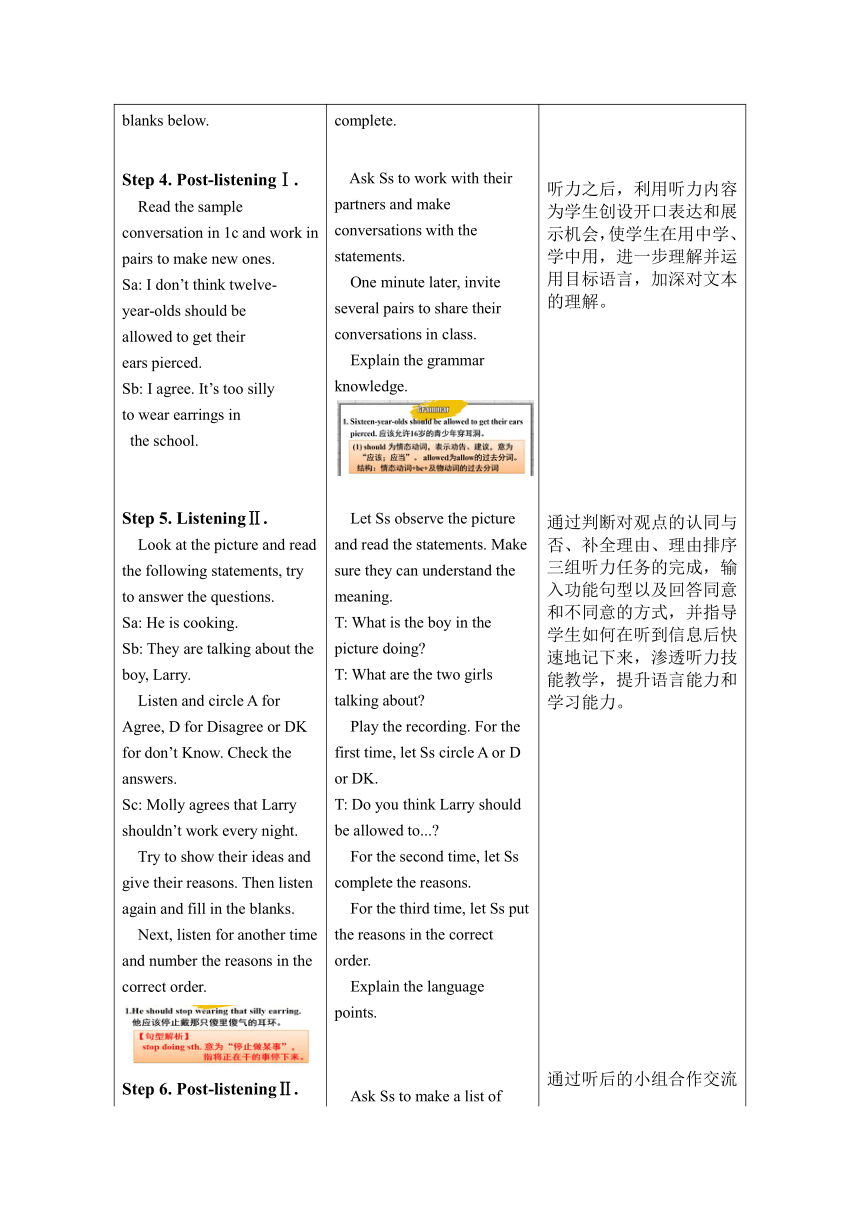【核心素养目标】Unit 7 Teenagers should be allowed to choose their own clothes. Section A (1a-2d)表格式教案
文档属性
| 名称 | 【核心素养目标】Unit 7 Teenagers should be allowed to choose their own clothes. Section A (1a-2d)表格式教案 |  | |
| 格式 | docx | ||
| 文件大小 | 614.7KB | ||
| 资源类型 | 教案 | ||
| 版本资源 | 人教新目标(Go for it)版 | ||
| 科目 | 英语 | ||
| 更新时间 | 2024-09-24 10:49:48 | ||
图片预览



文档简介
课题 Unit 7 Teenagers should be allowed to choose their own clothes. Section A (1a-2d) 班级 备课教师
课型 听说课 课时 1
核心素养与思政渗透 本课时围绕“规则”展开,引导学生来谈论日常生活中青少年能做和不能做的事情。学生在此语境下,学习正确使用含有情态动词的被动语态。通过理解和谈论青少年被允许或不被允许做的事情并表达同意或不同意,陈述自己的理由等,了解中西方教育观点、教育方法和行为准则上的异同,并增强自觉遵规守纪的意识;
课标分析 新课标要求九年级学生能听懂发音清晰、语速较慢的简短口头表达,获取关键信息;能围绕相关主题,运用所学语言,与他人进行日常交流,语音、语调,用词基本正确,表达比较连贯;能理解与感悟中外优秀文化的内涵;领会所学简短语篇蕴含的人文精神、科学精神和劳动价值,感悟诚实、友善等中外社会生活中的传统美德;能自尊自爱,正确认识自我,关爱他人,尊重他人,有社会责任感;有积极主动的学习态度和较强的自信心;能主动参与课内外各种英语实践活动,注意倾听,积极使用英语进行交流;能在学习过程中积极与他人合作,共同完成学习任务。
教学目标 语言能力 能够在谈论日常生活中的规则的情境中,正确使用含有情态动词的被动语态,以听说等方式理解和谈论青少年被允许或不被允许做的事情并表达同意或不同意,并陈述自己的理由;能够通过听前预测,从对话中捕捉细节信息并恰当表达,促进听说能力的提升;
文化意识 能够通过谈论规则,了解中西方教育观点、教育方法和行为准则上的异同,并增强自觉遵规守纪的意识;
思维品质 能够在听说活动中准确获取并表达有关青少年能做和不能做的事情的信息,并联系自身表达个人观点和看法,提高思维的逻辑性、批判性和创新性,实现知识与思维能力的迁移;
学习能力 通过谈论日常生活中的规则,激发对英语学习的兴趣;通过听说等各项技能策略的感悟、体验和学习,形成良好的学习习惯,提高学习效率;能在学习活动中积极与他人合作,共同完成学习任务。
教材内容分析 本课时为本单元第一课时,是一节听说课。1a-1c通过图文及听力活动导入单元话题:哪些事情是允许青少年做的,哪些事情是不允许做的;2a-2d听说活动的主要目的在于巩固和拓展本单元话题、语法和句型。
重点 情态动词后接被动语态的用法;
难点 由情态动词should构成的被动语态结构“should(not) be allowed to”的正确使用;
学情分析 通过前两个单元的学习,学生对英语的被动语态已经有了基本的了解,语言感知能力较强,这是学习本课时的优势。一方面学生学习积极性较高,另一方面,到了九年级,学生在学习上出现了分化现象,有的学生英语语言基础薄弱,语言拓展运用能力较差,而且在学习过程中缺乏耐性,因此,老师要鼓励学生积极学习,以灵活多样的教学活动设计激发学生的学习兴趣,并渗透学法指导引导学生逐步养成或巩固原有的良好学习习惯。
第 页
教 学 流 程
设 计 教 学 过 程 设 计 意 图
学 生 活 动 教 师 导 学
Step 1. Lead-in. Enjoy the song and have a free talk about rules they have. Ss: Rules. Sa: I can’t talk loudly in class. Sb: I have to study hard and get good grades. Step 2. Pre-listeningⅠ. Observe the pictures and learn to express rules with “should (not) be allowed to”. Meanwhile, they can learn some new words from the pictures. Step 3. While-listeningⅠ. Read the instruction and statements. Try to explain them in Chinese. Watch a video and check Anna’s mother’s opinions. Listen and circle “T” (for true) or “F” (for false) in 1b. Listen again and fill in the blanks below. Step 4. Post-listeningⅠ. Read the sample conversation in 1c and work in pairs to make new ones. Sa: I don’t think twelve- year-olds should be allowed to get their ears pierced. Sb: I agree. It’s too silly to wear earrings in the school. Step 5. ListeningⅡ. Look at the picture and read the following statements, try to answer the questions. Sa: He is cooking. Sb: They are talking about the boy, Larry. Listen and circle A for Agree, D for Disagree or DK for don’t Know. Check the answers. Sc: Molly agrees that Larry shouldn’t work every night. Try to show their ideas and give their reasons. Then listen again and fill in the blanks. Next, listen for another time and number the reasons in the correct order. Step 6. Post-listeningⅡ. Work in groups and have a discussion about the things teenagers should and should not be allowed to do. Sa: Do you think teenagers should wear the school uniforms Sb: Yes, I think so. ... Step 7. Role-play. Try to answer the questions according to their daily life. Read the conversation and try to answer the questions. Role-play the conversation in pairs and in class. Step 8. Summary. Have a summary of the useful expressions, sentences and function. Play an English song — The mom song. T: What are Moms talking about T: No rules, no games. Do you have any rules at home or at school Present some pictures about different kinds of rules. Explain some new words. Then, have a brainstorming with Ss. Guide Ss to read the statements in 1a and make sure they can understand the meaning. Play the video and ask Ss to check Anna’s mother’s opinions. Play the recording and let Ss make judgments. Provide the conversation with some blanks for Ss to complete. Ask Ss to work with their partners and make conversations with the statements. One minute later, invite several pairs to share their conversations in class. Explain the grammar knowledge. Let Ss observe the picture and read the statements. Make sure they can understand the meaning. T: What is the boy in the picture doing T: What are the two girls talking about Play the recording. For the first time, let Ss circle A or D or DK. T: Do you think Larry should be allowed to... For the second time, let Ss complete the reasons. For the third time, let Ss put the reasons in the correct order. Explain the language points. Ask Ss to make a list of things teenagers should and should not be allowed to do. Discuss their list with partners. Provide some questions to guide Ss to think the rules of visiting museums. Provide some questions for Ss to catch the key information in the conversation. Explain some language points. 通过一首“妈妈唠叨歌”,激发兴趣,导入“规则”话题。通过引导学生列举家庭和学校规则,激活其背景知识,为下一步谈论做好词汇准备。 通过旧知引新知,将曾经学过的规矩套用本课时的目标语言进行表达,将知识自然过渡迁移。同时,在语境中渗透生词教学,并利用头脑风暴的形式激发学生的学习热情,为后面的学习做好语言基础的铺垫。 结合主题图场景,将本单元话题、语法和句型真实地呈现出来,训练学生在听的过程中捕捉细节信息的能力。 听力之后,利用听力内容为学生创设开口表达和展示机会,使学生在用中学、学中用,进一步理解并运用目标语言,加深对文本的理解。 通过判断对观点的认同与否、补全理由、理由排序三组听力任务的完成,输入功能句型以及回答同意和不同意的方式,并指导学生如何在听到信息后快速地记下来,渗透听力技能教学,提升语言能力和学习能力。 通过听后的小组合作交流活动,引导学生巩固所学的功能句型,培养其较好的语言表达习惯和运用目标语言进行交际的能力。 问题引领,通过回答问题,让学生对对话从读前预测到整体感知再到细节理解,做到最大程度的掌握。 角色扮演让学生体会语音语调的表情达意功能。
第 页
课 时 达 标 检 测
Ⅰ. 单选题。 ( ) 1. —How often do I need to feed the dog —It ___ food every day, or it will be hungry. A. must give B. must be gave C. must be given ( ) 2.—Math is as interesting as English, I think. —_______. English is more interesting than math. A. I think so B. I don’t think so C. I don’t hope so ( ) 3.—What are you going to do this morning, Mary —My hair is too long, I want to get it _________. cut B. to cut C. cuts Ⅱ. 用方框中所给单词的适当形式填空。 earring, license, flash, smoke, part-time 1.Congratulations! You have got a driver's , and you can drive around now. 2.Tina did many jobs to pay for her education. 3.It's a little dark. You'd better use the when you take photos. 4.Look at the sign!I think it's impolite in public. 5.The girl with gold is Tom's sister. Ⅲ.根据汉语意思完成句子。 11.对于今年即将到来的国庆节我非常激动。 I'm quite the coming National Day this year. 12.今天下午我要去镇上理发。 I'm going to have in town this afternoon. 13.他需要一些时间完成作业。 He needs some time his homework. 14.在那个年龄,年轻人都不够严肃。 Young people weren't at that age. 15.图书馆的书不准转借他人。 The books of the library to others.
第 页
课 时 教 学 设 计 尾 页
板 书 设 计
Unit 7 Teenagers should be allowed to choose their own clothes. (Section A 1a-2d)
作 业 设 计
Level A Write a short passage to introduce the things teenagers should and shouldn’t be allowed to do you’ve learned this lesson. Some reasons can be added.
Level B Suppose you’re the staff in the art museum, write a short passage to introduce the things visitors should and shouldn’t be allowed to do based on 2d. More rules can be added.
教 学 反 思
第 页
课型 听说课 课时 1
核心素养与思政渗透 本课时围绕“规则”展开,引导学生来谈论日常生活中青少年能做和不能做的事情。学生在此语境下,学习正确使用含有情态动词的被动语态。通过理解和谈论青少年被允许或不被允许做的事情并表达同意或不同意,陈述自己的理由等,了解中西方教育观点、教育方法和行为准则上的异同,并增强自觉遵规守纪的意识;
课标分析 新课标要求九年级学生能听懂发音清晰、语速较慢的简短口头表达,获取关键信息;能围绕相关主题,运用所学语言,与他人进行日常交流,语音、语调,用词基本正确,表达比较连贯;能理解与感悟中外优秀文化的内涵;领会所学简短语篇蕴含的人文精神、科学精神和劳动价值,感悟诚实、友善等中外社会生活中的传统美德;能自尊自爱,正确认识自我,关爱他人,尊重他人,有社会责任感;有积极主动的学习态度和较强的自信心;能主动参与课内外各种英语实践活动,注意倾听,积极使用英语进行交流;能在学习过程中积极与他人合作,共同完成学习任务。
教学目标 语言能力 能够在谈论日常生活中的规则的情境中,正确使用含有情态动词的被动语态,以听说等方式理解和谈论青少年被允许或不被允许做的事情并表达同意或不同意,并陈述自己的理由;能够通过听前预测,从对话中捕捉细节信息并恰当表达,促进听说能力的提升;
文化意识 能够通过谈论规则,了解中西方教育观点、教育方法和行为准则上的异同,并增强自觉遵规守纪的意识;
思维品质 能够在听说活动中准确获取并表达有关青少年能做和不能做的事情的信息,并联系自身表达个人观点和看法,提高思维的逻辑性、批判性和创新性,实现知识与思维能力的迁移;
学习能力 通过谈论日常生活中的规则,激发对英语学习的兴趣;通过听说等各项技能策略的感悟、体验和学习,形成良好的学习习惯,提高学习效率;能在学习活动中积极与他人合作,共同完成学习任务。
教材内容分析 本课时为本单元第一课时,是一节听说课。1a-1c通过图文及听力活动导入单元话题:哪些事情是允许青少年做的,哪些事情是不允许做的;2a-2d听说活动的主要目的在于巩固和拓展本单元话题、语法和句型。
重点 情态动词后接被动语态的用法;
难点 由情态动词should构成的被动语态结构“should(not) be allowed to”的正确使用;
学情分析 通过前两个单元的学习,学生对英语的被动语态已经有了基本的了解,语言感知能力较强,这是学习本课时的优势。一方面学生学习积极性较高,另一方面,到了九年级,学生在学习上出现了分化现象,有的学生英语语言基础薄弱,语言拓展运用能力较差,而且在学习过程中缺乏耐性,因此,老师要鼓励学生积极学习,以灵活多样的教学活动设计激发学生的学习兴趣,并渗透学法指导引导学生逐步养成或巩固原有的良好学习习惯。
第 页
教 学 流 程
设 计 教 学 过 程 设 计 意 图
学 生 活 动 教 师 导 学
Step 1. Lead-in. Enjoy the song and have a free talk about rules they have. Ss: Rules. Sa: I can’t talk loudly in class. Sb: I have to study hard and get good grades. Step 2. Pre-listeningⅠ. Observe the pictures and learn to express rules with “should (not) be allowed to”. Meanwhile, they can learn some new words from the pictures. Step 3. While-listeningⅠ. Read the instruction and statements. Try to explain them in Chinese. Watch a video and check Anna’s mother’s opinions. Listen and circle “T” (for true) or “F” (for false) in 1b. Listen again and fill in the blanks below. Step 4. Post-listeningⅠ. Read the sample conversation in 1c and work in pairs to make new ones. Sa: I don’t think twelve- year-olds should be allowed to get their ears pierced. Sb: I agree. It’s too silly to wear earrings in the school. Step 5. ListeningⅡ. Look at the picture and read the following statements, try to answer the questions. Sa: He is cooking. Sb: They are talking about the boy, Larry. Listen and circle A for Agree, D for Disagree or DK for don’t Know. Check the answers. Sc: Molly agrees that Larry shouldn’t work every night. Try to show their ideas and give their reasons. Then listen again and fill in the blanks. Next, listen for another time and number the reasons in the correct order. Step 6. Post-listeningⅡ. Work in groups and have a discussion about the things teenagers should and should not be allowed to do. Sa: Do you think teenagers should wear the school uniforms Sb: Yes, I think so. ... Step 7. Role-play. Try to answer the questions according to their daily life. Read the conversation and try to answer the questions. Role-play the conversation in pairs and in class. Step 8. Summary. Have a summary of the useful expressions, sentences and function. Play an English song — The mom song. T: What are Moms talking about T: No rules, no games. Do you have any rules at home or at school Present some pictures about different kinds of rules. Explain some new words. Then, have a brainstorming with Ss. Guide Ss to read the statements in 1a and make sure they can understand the meaning. Play the video and ask Ss to check Anna’s mother’s opinions. Play the recording and let Ss make judgments. Provide the conversation with some blanks for Ss to complete. Ask Ss to work with their partners and make conversations with the statements. One minute later, invite several pairs to share their conversations in class. Explain the grammar knowledge. Let Ss observe the picture and read the statements. Make sure they can understand the meaning. T: What is the boy in the picture doing T: What are the two girls talking about Play the recording. For the first time, let Ss circle A or D or DK. T: Do you think Larry should be allowed to... For the second time, let Ss complete the reasons. For the third time, let Ss put the reasons in the correct order. Explain the language points. Ask Ss to make a list of things teenagers should and should not be allowed to do. Discuss their list with partners. Provide some questions to guide Ss to think the rules of visiting museums. Provide some questions for Ss to catch the key information in the conversation. Explain some language points. 通过一首“妈妈唠叨歌”,激发兴趣,导入“规则”话题。通过引导学生列举家庭和学校规则,激活其背景知识,为下一步谈论做好词汇准备。 通过旧知引新知,将曾经学过的规矩套用本课时的目标语言进行表达,将知识自然过渡迁移。同时,在语境中渗透生词教学,并利用头脑风暴的形式激发学生的学习热情,为后面的学习做好语言基础的铺垫。 结合主题图场景,将本单元话题、语法和句型真实地呈现出来,训练学生在听的过程中捕捉细节信息的能力。 听力之后,利用听力内容为学生创设开口表达和展示机会,使学生在用中学、学中用,进一步理解并运用目标语言,加深对文本的理解。 通过判断对观点的认同与否、补全理由、理由排序三组听力任务的完成,输入功能句型以及回答同意和不同意的方式,并指导学生如何在听到信息后快速地记下来,渗透听力技能教学,提升语言能力和学习能力。 通过听后的小组合作交流活动,引导学生巩固所学的功能句型,培养其较好的语言表达习惯和运用目标语言进行交际的能力。 问题引领,通过回答问题,让学生对对话从读前预测到整体感知再到细节理解,做到最大程度的掌握。 角色扮演让学生体会语音语调的表情达意功能。
第 页
课 时 达 标 检 测
Ⅰ. 单选题。 ( ) 1. —How often do I need to feed the dog —It ___ food every day, or it will be hungry. A. must give B. must be gave C. must be given ( ) 2.—Math is as interesting as English, I think. —_______. English is more interesting than math. A. I think so B. I don’t think so C. I don’t hope so ( ) 3.—What are you going to do this morning, Mary —My hair is too long, I want to get it _________. cut B. to cut C. cuts Ⅱ. 用方框中所给单词的适当形式填空。 earring, license, flash, smoke, part-time 1.Congratulations! You have got a driver's , and you can drive around now. 2.Tina did many jobs to pay for her education. 3.It's a little dark. You'd better use the when you take photos. 4.Look at the sign!I think it's impolite in public. 5.The girl with gold is Tom's sister. Ⅲ.根据汉语意思完成句子。 11.对于今年即将到来的国庆节我非常激动。 I'm quite the coming National Day this year. 12.今天下午我要去镇上理发。 I'm going to have in town this afternoon. 13.他需要一些时间完成作业。 He needs some time his homework. 14.在那个年龄,年轻人都不够严肃。 Young people weren't at that age. 15.图书馆的书不准转借他人。 The books of the library to others.
第 页
课 时 教 学 设 计 尾 页
板 书 设 计
Unit 7 Teenagers should be allowed to choose their own clothes. (Section A 1a-2d)
作 业 设 计
Level A Write a short passage to introduce the things teenagers should and shouldn’t be allowed to do you’ve learned this lesson. Some reasons can be added.
Level B Suppose you’re the staff in the art museum, write a short passage to introduce the things visitors should and shouldn’t be allowed to do based on 2d. More rules can be added.
教 学 反 思
第 页
同课章节目录
- Unit 1 How can we become good learners.
- Section A
- Section B
- Unit 2 I think that mooncakes are delicious!
- Section A
- Section B
- Unit 3 Could you please tell me where the restroom
- Section A
- Section B
- Unit 4 I used to be afraid of the dark.
- Section A
- Section B
- Unit 5 What are the shirts made of?
- Section A
- Section B
- Review of Units 1-5
- Unit 6 When was it invented?
- Section A
- Section B
- Unit 7 Teenagers should be allowed to choose their
- Section A
- Section B
- Unit 8 It must belong to Carla.
- Section A
- Section B
- Unit 9 I like music that I can dance to.
- Section A
- Section B
- Unit 10 You're supposed to shake hands.
- Section A
- Section B
- Review of Units 6-10
- Unit 11 Sad movies make me cry.
- Section A
- Section B
- Unit 12 Life is full of the unexpected
- Section A
- Section B
- Unit 13 We're trying to save the earth!
- Section A
- Section B
- Unit 14 I remember meeting all of you in Grade 7.
- Section A
- Section B
- Review of Units 11-14
